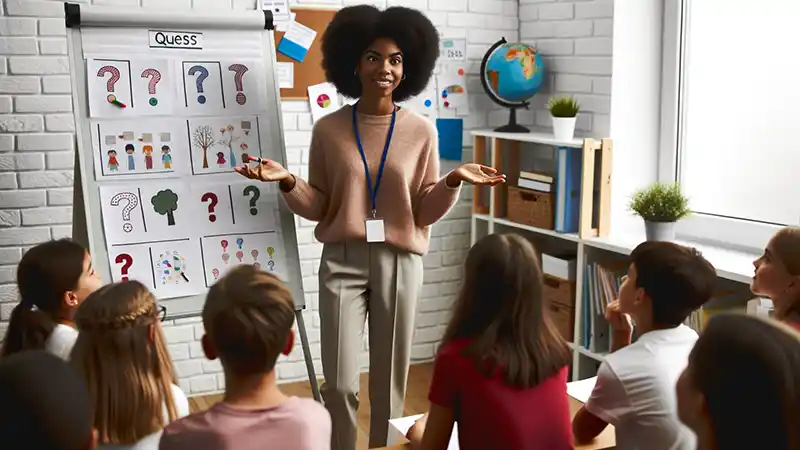Classroom management is, without a doubt, one of the most challenging aspects of teaching. Every educator, whether they’re just beginning their journey or they’re seasoned pros, will tell you tales of that one class period where nothing went as planned. Distractions, varying student needs, unexpected interruptions, and the need to keep every student engaged – these are all part of the intricate dance of running a classroom.
In the heart of these challenges, there lies a tool, often underutilized but incredibly effective, known as anchor activities. If you haven’t come across this term before, or even if you have but haven’t delved deeply into its potentials, you’re in for a transformative insight. Anchor activities can be a beacon of order in the sometimes-chaotic world of teaching, helping not just to manage but to truly optimize the classroom experience for both educators and students.
What are Anchor Activities?
Anchor activities are essentially tasks or assignments designed to “anchor” students when they’ve completed the main lesson or assignment and are waiting for further instructions or the next phase of a lesson. These activities aren’t just time-fillers; they’re meaningful assignments that either reinforce previous learning or introduce students to new concepts in a self-directed manner.
Picture this: you’re in the middle of a lesson, and a handful of your students whizz through the main task. They’re now looking around, waiting for what’s next, or, worse, looking for mischief to get into. This is where anchor activities come in handy. They provide these early finishers with structured tasks that keep them engaged and learning, while you attend to students who need additional support or move on to the next section of your lesson.
Common examples in classrooms:
Independent Reading: This can be from a list of recommended books or free choice, as long as it’s relevant to the subject at hand.
Journal Prompts: Students can reflect on what they’ve learned, write about a related topic, or explore their own thoughts about the day’s lesson.
Extension Projects: For those students who are eager to delve deeper, offer projects that expand on the lesson’s main topic.
Skill Reinforcement Worksheets: These are particularly useful in subjects like Math, where students can benefit from additional practice on a particular skill.
Peer Review: If the primary task was, say, an essay or a short answer assignment, students can swap and provide feedback to their peers.
Tech-based Learning Platforms: Tools like Khan Academy, Duolingo, or other educational apps can provide subject-relevant tasks for students.
Creative Expression: Encourage students to create art, write poetry, or even come up with a song related to the day’s lesson.
Benefits of Using Anchor Activities

As teachers, we’re always on the hunt for methods that not only make our lives easier but also enrich our students’ learning experiences. Anchor activities seamlessly fit into this category, bringing a multitude of benefits to the classroom. Let’s delve into some of the prominent advantages.
Improved Student Engagement:
The energy in a classroom where students are actively engaged is palpably different. Anchor activities capture and retain students’ attention, ensuring they’re constantly involved in a learning process. Rather than having students drift into daydreams or distracting chatter, anchor tasks keep their minds focused on educational content. When students are engaged, they’re not just passively absorbing information but actively interacting with it, leading to better retention and understanding.
Differential Instruction:
Every classroom is a mosaic of diverse learners – some grasp concepts quickly, while others need a bit more time. Anchor activities cater to this diversity. Advanced learners can be challenged with more intricate tasks, ensuring they’re not left feeling unstimulated. Simultaneously, while these learners are occupied, educators can provide more focused attention to students who might need additional help.
Reduction in Downtime:
Those gaps in between lessons, when one task ends and another hasn’t quite begun, can be the bane of smooth classroom operations. These moments of downtime, though seemingly brief, can lead to disruptions. Anchor activities fill these gaps, ensuring students always have a purposeful task at hand. This keeps the momentum of the lesson going, making transitions smoother and more efficient.
Enhanced Classroom Discipline:
A busy student is less likely to be a disruptive student. With the continuous engagement that anchor activities provide, there’s a significant reduction in off-task behaviors. When students are engrossed in meaningful tasks, the chances of distractions, side conversations, and other disruptions decrease. This creates a calmer, more orderly classroom environment conducive to learning.
Flexibility for Teachers:
With a portion of the class meaningfully occupied, teachers find they have a bit more breathing space. This offers a golden opportunity for one-on-one instruction. Whether it’s helping a struggling student, challenging an advanced learner with deeper questions, or simply checking in on students’ well-being, this flexibility is a boon for effective teaching.
Implementing Anchor Activities: Best Practices
Anchor activities, like any tool in an educator’s toolkit, are most effective when used thoughtfully and strategically. As we delve into the world of these activities, it’s crucial to understand the best practices associated with their implementation. Here’s a guide to getting the most out of anchor activities:
Choosing Relevant and Meaningful Tasks:
At the core of any anchor activity’s success is its relevance to the ongoing curriculum and its ability to engage the student meaningfully. When selecting or designing these tasks:
Link with Curriculum: Ensure the activity ties back to the lessons being taught, reinforcing concepts or introducing related ones.
Purpose Over Busy Work: Avoid giving students rote or repetitive tasks. Instead, focus on those that stimulate thinking, creativity, or skill enhancement.
Variety is Key: Mix up the type of tasks – from reading assignments to hands-on projects, ensuring there’s something to captivate every student’s interest.
Ensuring Activities Cater to Different Learning Styles:
Every student learns differently. While some might be auditory learners, others might thrive with visual or kinesthetic tasks. Anchor activities should reflect this diversity:
Visual Tasks: Infographics, reading assignments, or visual puzzles.
Auditory Tasks: Listening to a relevant podcast or an audio lesson.
Kinesthetic Tasks: Hands-on experiments, building models, or even acting out scenarios.
Interactive Learning: Digital platforms or group tasks that encourage collaboration and discussion.
To differentiate any task, see our Differentiated Instructor AI Tool.
Regularly Rotating and Updating Activities:
Using the same anchor activities repeatedly can lead to monotony and decreased engagement. Keep the approach fresh:
Change is Good: Rotate tasks every few weeks to keep students’ interest piqued.
Seek Feedback: Occasionally, get feedback from students on which activities they found most engaging or beneficial.
Stay Updated: The educational world is always evolving, with new resources and tools becoming available. Regularly update your anchor activity list to incorporate fresh materials.
Potential Drawbacks and Solutions

Like any teaching strategy, anchor activities are not without their challenges. However, being aware of these potential pitfalls and knowing how to navigate them can ensure that these activities remain an effective tool in the classroom. Let’s explore some common concerns and their solutions:
Overwhelming Students with Excessive Work:
While anchor activities aim to keep students engaged, there’s a fine line between constructive engagement and overwhelming them with what might feel like “extra” work.
Solution: It’s essential to balance the rigor and quantity of anchor activities. Ensure tasks are reasonably paced, and always emphasize their purpose as an opportunity for enrichment, not just more work.
Not All Activities Resonate with Every Student:
What captivates one student might not interest another, leading to uneven engagement.
Solution: Offer a choice. Instead of assigning a single activity, provide students with a few options to select from. This caters to diverse interests and learning styles, increasing the likelihood of engagement.
Risk of Over-reliance on Anchor Activities:
If used too frequently, there’s a potential that students come to expect and wait for these activities instead of focusing on the main lesson.
Solution: Use anchor activities judiciously. They should complement the core lesson, not overshadow it. Ensure the primary instruction remains the focal point.
Managing Different Activities Simultaneously:
With multiple students working on various tasks, classroom management can become a challenge.
Solution: While offering choices is good, avoid having too many different activities at once. Limit options to a manageable number, ensuring you can oversee all tasks without feeling stretched.
Not Updating Activities Regularly:
Using outdated or repetitive anchor activities can lead to decreased student interest and engagement.
Solution: Stay proactive in updating your activity list. Regularly source new materials, get student feedback, and be willing to refresh tasks to keep them relevant and engaging.
Time Consumption in Preparation:
Creating or sourcing relevant anchor activities can be time-consuming for teachers.
Solution: Collaborate with fellow educators. Share resources, brainstorm together, and even consider setting up a shared repository of anchor activities that all can access and contribute to.
Conclusion
The world of education is dynamic, with classrooms serving as the crucible where innovation, challenges, and breakthroughs converge. Amid this ever-evolving landscape, anchor activities have emerged as a transformative tool, addressing the very heart of classroom management. These tasks, far from being mere fillers, play a pivotal role in ensuring continuous student engagement, bridging gaps in understanding, and maintaining a harmonious, productive classroom environment.
The magic of anchor activities lies in their versatility. They are adaptable to various subjects, grade levels, and even individual student needs, making them an invaluable asset in the diverse world of education. And while they do come with their set of challenges, as any instructional method might, the rewards—when implemented thoughtfully—are truly significant.
To my fellow educators, the journey of teaching is one of perpetual learning and adaptation. Anchor activities offer a fresh avenue, a new strategy to explore. I encourage you to experiment with these tools, tailor them to your unique classroom needs, and witness the potential transformation they can bring. In doing so, you won’t just be managing your classroom; you’ll be elevating it, creating a space where every moment is an opportunity for growth and discovery. Dive in, innovate, and let anchor activities anchor your teaching success.

